
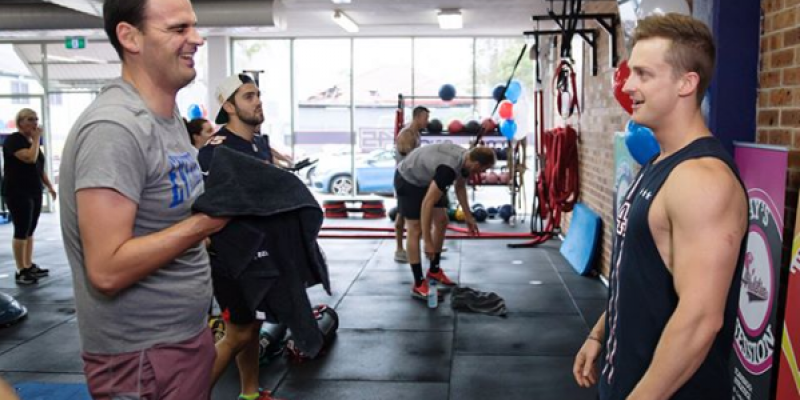
Modifying the F45 diet may be simple for those who have a higher level of dietary skills or experience, but many are struggling to find answers.
About the author (Simon): For 4 years I worked as the head trainer at F45 Wollongong (NSW, Australia), at which time I was completing my nutrition degree at the University of Wollongong. F45 sold out Australia wide in only 4 years and is quickly becoming a global phenomenon! Whilst at Wollongong F45 I ran 20+ challenges, including nutrition seminars, personal nutrition consults and was constantly giving out nutrition advice to clients.
A frequent question client would ask is: “How can I modify the a F45 diet” but this question came in all shapes and sizes – thus this guide has been created!
This is your definitive guide to modifying the F45 diet from a F45 veteran and qualified university level nutritionist! Enjoy!
I am not officially affiliated to the F45 anymore. I do not make money off this post (unless you want me to be your nutrition coach) but rather I just hope to offer some clarity to those struggling whilst using the F45 eating plan. Enough said…
Table of content:
I realize that many of you may be dieting FOR THE FIRST TIME, thus I have kept this post relatively simple and included definitions so it is easy to follow. Okay, let’s get started and level up your dietary skills!
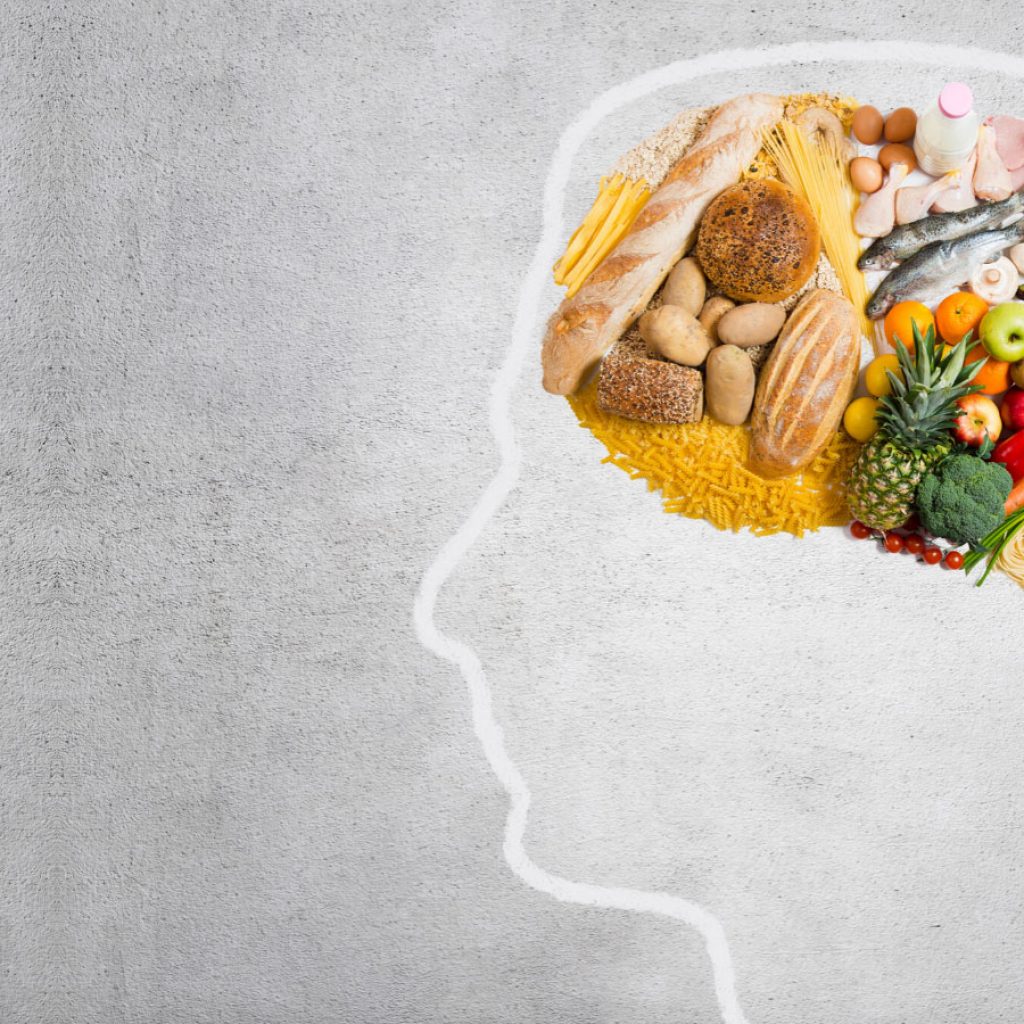
Firstly it is important to have a basic understanding of the building blocks of food which his proteins carbs and fats also known as your macronutrients. Also, calories are the most important factor for body composition changes. If your not hitting your calories appropriately, your macronutrient ratios or adequate protein intake will not matter as much! We will also dig into a bit of detail about the micronutrients. We will also touch briefly on the order of priorities (which things to focus on first).
Once you know all this, you’ll be able to easily modify the F45 eating plan to suit your lifestyle
The food that we Digest is primarily build-up of macronutrients and micronutrients. The macronutrients are proteins carbohydrates fats and also fibre.
Proteins– 4 calories per gram
Protein is Essential for building lean body mass and repairing damage to muscles and tissue after training. Having adequate protein intake has been shown to help preserve lean body mass and aid in gaining muscle mass. Protein has the highest satiety effect out of all of the macronutrients which means it makes up feel full for longer!
Carbohydrates – 4 calories per gram
Carbs primarily just give us energy. Energy to move, think and function! We need carbs to function, but it is easy to consume too much. Carbohydrates do not fill us up (satiety) as much as protein does. Processed carbs often have the protein and fibre removed to increase their “palatability” (fancy descriptive word for how foods feel while you are chewing them). Once again, we need carbohydrates!
Fats – 9 calories per gram
Fats are also our friends. They provide us with building blocks for our cells and support our hormone production.
Fibre
The 4th macronutrient but not often spoken about. Fibre is essential for our gut health and slows down the absorption of food – giving us a slow release of energy. It is important to keep fibre rich foods in our diet as recent research has been linking our gut health to depression, auto-immune diseases and even our appetite control.
Macro-Nutrient ratios
There is a ratio between the 3 main macro nutrients (protein, carb, fats) that is important to understand (but not as important as you mite think, ill explain more on this later). Most balanced diets will have a balanced ratio of the proteins, carbs and fats.
For example:
Keto/ Low Carb: P – 40-50% F – 20-50% C-10-20%
Zone Diet: P – 30% F- 30% C-40%
Low Fat Diet – P – 30% F – 15-20% C-50-55%
As you can see from these examples there is various amounts of protein carb and fats in each dietary style! Okay, now that we know the basics, lets move on to calories and micronutrients!
Make no doubt about it, calories are still the king! No diet plan works without a calorie deficit and it is important to remember that hitting your daily calorie allowance is the NUMBER 1 PRIORITY.
Calorie counting may not be as effective as may not actually be as effective as Macro tracking. I wont go into the reasons why in the post but may cover it in a future post. Tracking macros is great for keeping your calories in check. In fact, this is why the “If it fit yours macros (IIFYM)” movement has been so popular.
The foods we eat have more than just proteins, carbs, fats and fibre. They also are full of tiny little nutrients that we need in smaller amounts. We need micro (small) amounts of these nutrients to function optimally. They have a range of health benefits to having a surplus of these nutrients! To stay focused on the topic, I wont dig too deep into micronutrients.
Just know that they exist and you want to eat a range of nutrient dense foods to ensure you are having adequate intake. The common diet professionals advise is to “eat a LARGE variety of foods to ensure micronutrient requirements”, however, I personally believe eating TOO MUCH variety is worse idea than just eating 10-15 nutrient dense foods on a regular basis.
Why? Because too much variety creates complexity in your diet (more calculations, different cooking, different prepping etc) whereas you could be achieving an abundance of nutrients from consuming 10-15 nutrient dense foods regularly and making it a habit. I digress, lets get back on topic.
Since I have just covered the main categories, it is now important to know what level of priority they should hold. Some people focus so much on supplements, micronutrients or achieving a certain macro goal that they loose sight of the most important factor, total calorie intake.
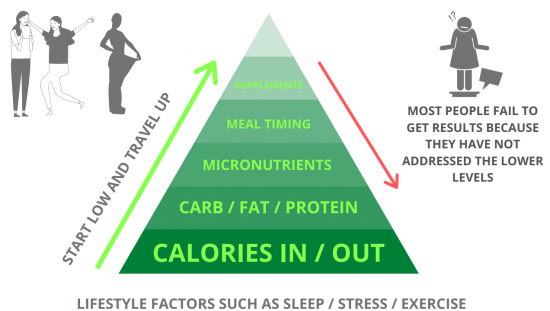
This is the nutrition pyramid of priorities, popularised by Eric Helms, but the original concept has been floating around for awhile longer.
This pyramid represents how your priorities should be focused, starting at the energy balance (calories in vs calories out) and working your way up to the top (supplements).
The majority of the results will come from addressing the calories, followed by macronutrients. When these are in order (hitting your targets daily), then you would focus more-so on your micronutrients, meal timing and supplements
Okay, now you know all you need to know about nutrition, lets move on to the F45 diet
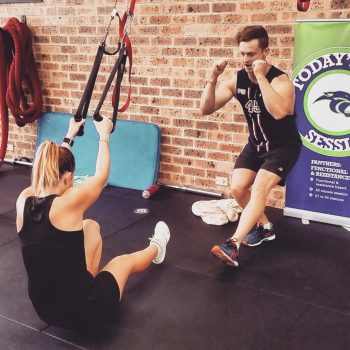
The calories of the F45 diet are not mentioned often, and have changed over time. They used to sit at 1300 for girls and 1800 for guys. They now range closer to 1400 for girls and 1900 for guys.
There are 3 main phases of the F45 Diet – Spring training, Regular season and World series. Each phase is boasted to have different benefits with emphasis on things ranging from vegetables, macronutrients, micronutrients. There is also a range of ambiguous terms such as “help you achieve your goals”, “discover the power of macronutrients” or “kick your health into high gear” used to describe the phases.
The fact of the matter is, all 3 phases contain vegetables, higher amounts of protein and also plenty of micronutrients. These phases never stood out to me as anything impressive, in fact, they are similar to the varying F45 class names – meaningless and a simple (yet smart) attempt to give the classes a unique feel.
The macronutrient ratio of the phase does apparently change, although this information has been recently hidden from any F45 information source that I can find, you may be able to track it down. Or if you are unable to locate the phase macronutrient ratio online – simply enter 2-3 days of the diet plan into a dietary tracking software such as myfitnesspal and you will get a clear picture of the macro layout.

If you are going to replace food from the F45 diet with another food item you would want to make sure that the calories and macronutrients are equal. You can find the macronutrient information about that food on the F45 diet planner portal. Then you would simply just replace their food with another food item that has the same calories, and preferably the same protein carb and fat.
If the ingredient you are swapping is on my fitnesspal (or another nutrition tracking tool), you can swap it for another ingredient of equivalent macro value (protein, carb, fat)
Example: Changing ingredient – Blueberries
Since blueberries is a carb based food, you could easily swap it for banana, oats, apple, rice cakes, raspberries, etc.
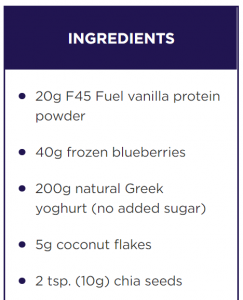
Example: Changing ingredient – Vanilla Protein Powder
Since Protein Powder is a protein based food, you could easily swap it for beef, chicken, tofu, tempeh, high protein yoghurt, salmon or other protein foods
If you are REMOVING or choosing not to add an ingredient, you would probably want to replace it with something else (same process as above). If the ingredient has minimal calories / macros then you can just discard it and move on.
Once again, look at the nutrition information for the meal unsing the F45 online portal. Example:
Now, you have the information about the total calories, protein, fats and carbs. You can replace the meal with another meal with the same calories or macros. You can easily replace a meal with another meal on the F45 eating plan of the same nutritional targets.
You could just use the calories (439 calories) and find another F45 meal that has the same amounts (or close to it)
If you are wishing to keep the same macronutrient balance, you may want to look at the macros and choose an alternative meal with the same numbers. This meal is moderate protein (30g), moderate fat (19.8g) and moderate carb (32.8g).
This will keep your daily macronutrient targets and calories all lined up, therefor you can proceed and keep the rest of the eating plan the same.
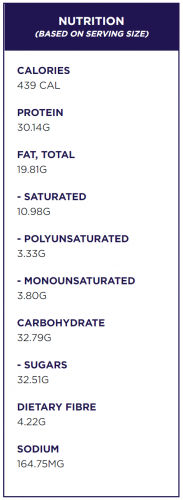
This is a common approach to the F45 diet. I have seen great results from those who have simplified the diet by just repeating the same day over and over. The calories will be lined up, the macros will be lined up and the should be adequate micronutrients.
The problem with this approach is that it doesn’t provide as much variety in your intake. Basically, you wont be eating a large variety of foods, thus you want to make sure that the foods you are eating at meeting your micronutrient targets
If you are choosing the do this approach it may be a good idea to add ALL of the ingredients of your day to an online nutrition calculating tool (such as myfitnesspal, easy diet diary, cronometer, etc) so to see that your intake is on track for your macronutrients & micronutrients.
You could also add a multivitamin into your daily routine to ensure that you are hitting all of your vitamin and mineral requirements. Then, proceed ahead with your challenge.
One last thing to mention – the 3 phases of the diet have different macronutrient layouts, if you wish to do this approach AND achieve the proposed benefits of each phase, consider repeating a day from phase 1 during phase 1, a day from phase 2 during phase 2, etc.
This is a great approach!
It is important to note that the “macro goals” change depending on the phase of the challenge. As listed previously, you may need to add up 1-3 days of the challenge phase on a diet tracking software to find out what macro ratio they are using. If you are still wanting to follow the phases of the challenge, here is an example of how to proceed:
All the information you need for this was listed above
Example:
Male 85kg = Calories: 1900, P C F (phase dependent)
Female 55kg = Calories 1400, P C F (phase dependent)
So all you would do is to break down your calories into your macro ratio. For the sake of this example we will use the Zone macro breakdown (P- 30%, F-30%, C-40%) as it is popular for body composition changes
Protein: 1400 x 30% = 420 calories for protein
Carb: 1400 x 40% = 560 calories for carb
Fat: 1400 x 30% = 420 calories for fat
Then divide the calories by the calorie value for the macro nutrient (listed in basic info above)
Protein: 420 / 4 = 105 grams
Carb: 560 / 4 = 140 grams
Fat: 420 / 9 = 47 grams
So there you have your macros! This could be used for most females trying to lose weight. Your welcome 🙂
Now you can start making your meals to fit those macros and you will get the same results (as long as your tracking skills are adequate)
You can now use a calculator tool such as myfitnesspal, cromium or easy diet diary to add up your macros as you go, or in advance
If adding up your meals in advance, you can do some planning and calculating on my fitness pal – then go shopping and buy all the ingredients!
This approach can work, but it may not be as effective for overall body composition and health as tracking macros. I don’t want to get into all the details (in this post).
Basically, it is because the macronutrients per meal may not be ideal, micronutrient inconsistency, eating timing infrequency etc.
Sticking to the same calories WILL STILL DELIVER RESULTS – but just know, they may not be optimal. People can lose weight eating MacDonald’s (with the correct calorie intake) but the body composition changes and health will not be optimal.
Since Found My Physique was created to help understanding the skills you need to control your diet and physique, I will not be recommending this method, however it can work fine for simplicity sake!
If you do this method, just spread out your meals and make sure to get adequate (20-35g) protein 3-4 times per day.
Intuitive eating is a combination of listening to your bodies signal (hunger, energy levels, workout performance, etc) and a long list of nutrition skills that can be learned
I would suggest NOT using this method (as it can be inaccurate) unless you have formed a routine accurate eating structure, achieved your ideal body composition, or are on the right the right trajectory.
Here is a basic list of some nutrition skills that I believe to be valuable for intuitive eating
Skill 1 – Eat 80-90% clear lean ingredients that are prepared at home
Skill 2 – Buy the same ingredients (and sizes) but change the flavours
Skill 3 – Buy ingredients that are already weighed so you do not have to weigh them!
Skill 4 – Buy calorie free spices, seasoning and herbs
Skill 5 – Make sure your mindful of additional calories from sauces and oils
Skill 6 – Do basic maths on foods that you buy when you are eating out
This would relate to the visual portion sizing example below
You can also look on my fitness pal if there is a record for the food you are thinking of ordering
You could use the listed calories / kilojoulz and mould the remaining meals in your day to match
Skill 7 – Do extra exercise or activities when you overeat or plan to overeat
Skill 8 – Use this general guideline for visually measuring portion sizes (pitcure)
Skill 9 – Have meal-macro goal based on your daily macro goals
This last skill I have found to be incredibly useful and have taught it in detail to hundreds on my dietary clients! It is such a simple skill but SO EFFECTIVE! If you eat 4 times per day, divide your daily macros by 4 and you will have your meal targets.
It is so simple and effective that I use it in all of my dietary programs. I calculate meals to these meal exactly macro requirements so clients know exactly how much they need to each and how many times per day to eat.
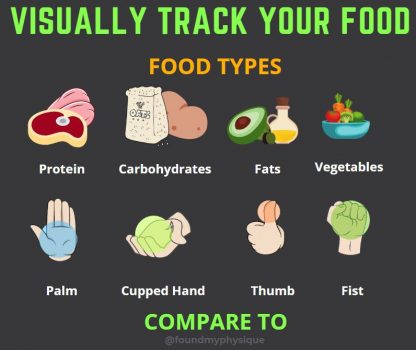
Hitting meal macro goals is a genius idea because it allows you to focus on the “here and now” and also have a target to prepare you meals for. When you focus on the whole day it can become vague and confusing.
I have found this dietary method to be super effective for long term results (its sustainable) as the clients can create other meals to those requirements. They are not stuck with limited options, and when they create new options, they know exactly how big to make those meals. Learn more about my personalised eating plans
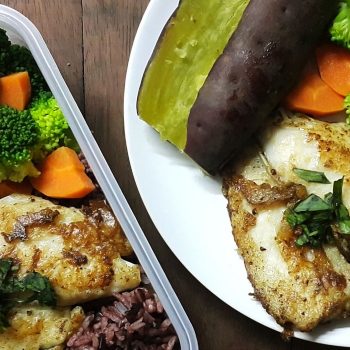
I’m bigger / taller than the average, how do I increase my Nutritional Intake?
I have seen 110kg male clients stick to the F45 eating plan and lose around 20kg in the 8 week challenge. Others have lost close to that amount but they also lose a fair bit of lean body mass. Remember, the goal is to lose body fat, not lean body mass. However, if you want to “get it done” then ide advise staying as healthy as possible and learning diet skills along the way that are useful after the challenge to prevent the common massive rebound!
If you are bigger than 90kg as a male or very active, you may want to increase your calories by 200-300. This can be done by simply having 30g of protein and 40g of carbs as a extra little snack. A protein shake and 1.5 bananas would suffice. As a tall or athletic female you may want to do the same.
Remember, everyone has unique requirements based on the size of their lean body mass (fat free mass), their incidental activity (walking, working etc) and how much / intense they train.
I have a different goal than ‘shredding’
If your goal is to gain weight, maintain weight or build muscle mass, then the standard F45 eating plan may not be for you. You may require a different amount of calories for you goal.
Every individual is unique and requires different calorie requirements based on their lean body mass, activity levels, workout regularity (and intensity) and also their goal
As a general guideline – if you are wanting to maintain weight, girls could stick to around 1600-1700 calories and guys could stick to 2300-2400 calories.
Once again, this is a rough guide. Remember, everyone has unique requirements and may require more personalised nutrition rather than a cookie cutter approach.
This is because your energy requirements are based on your lean body mass + your lifestyle activity + your exercise activity and also the small amount of energy that certain foods types take to be digested… But that is beyond the scope of this post.
What if i just use a meal prep service?
I have never seen this as a sustainable long term approach unless you are okay with eating boring meals and have the extra money to throw around. Most people would be better off working on their nutrition and cooking skills in order to make healthy meals themselves!
What is truly special about “meal prep meals”? They are basically clean healthy fresh options. Learn how to cook and prep for yourself. Your journey through life is a long one, do you really want to be average at fuelling yourself and making your body optimal? I think not!
This method can be useful if you are time poor, but I would not suggest it to anyone who is serious about finding their ideal body composition or trying to create a sustainable diet.
If you are doing the F45 challenge for a quick fix, yes, sure, go with the meal prep service. But if you want to make long term results, its never a good idea to offload responsibility (unless you can easily afford to do so)
What if I do extra training sessions?
If you are doing 2 sessions per day, you may want to increase your calories by 200-300. A protein shake and a couple pieces of fruit. If you do not do this you will lose weight faster than recommended and potentially lose muscle mass. Some individuals who are trying to make an amazing transformation will op for this approach, although, it can result in the loss of lean body mass if done incorrectly.
How can I prevent the loss of muscle mass?
Some basic principles to follow when trying to preserve the loss of lean body mass are as follows:
I’m going start tracking macros, how long should I track my intake for?
I think it is a good idea to track EVERYTHING for a few weeks. Until you are certain that your intake is accurate. After awhile you can slowly transition to intuitive eating.
Intuitive eating is more appropriate when you already have GREAT control over your diet. Until you are seeing noticeable results
Many of us have formed a HABIT of how we eat. We usually eat 15-30 meals on a regular basis.
It would be rare to find someone who is outside of this norm. Routine and regimented shopping / cooking / eating is something we all do to some degree. Incredibly fit and healthy people also do it!
The trick is to get that accurate healthy routine SET IN STONE… Then you can start intuative eating. Recommended Readings: The Power of Habit
This is why I teach my clients to track their nutrition initially then slowly transition to more laid back approaches as they are nearing their goal or atleast on course to achieving it.
I want to keep dieting but I don’t think the F45 calories are what I require?
Using the F45 calories is not for everyone, but is is good amount for the average male or female to shred. If you believe you have a different requirement, it may be a good idea to have your requirements calculated by a professional. Online tools can be inaccurate and end up making you waste your time

Cleansing is more myth and truth
What move detox diets / cleanse systems will tell you is that you body is full of toxic chemicals that are affecting your health. A 2009 review of popular detox systems showed that manufacturers cant even list what “harmful” chemicals their products are removing.
You body DOES accumulate some chemicals and compounds that are harmful, for example mercury, pesticides, plastics… But the “magic” way to reduce the amounts of these compounds is really simple… Ill explain it in a 3 step process:
A detox or cleanse will not be incredibly fast at “removing toxins”… But rather is usually applies step 1 and 2. The other benefits (such as weight loss and feeling better) are primary from eating less calories (which makes you lose weight) and eating less junk food (which can make you feel heavy, slow, bloated or low energy)
Take home message: Cleansing and detoxes are basically a way to waste money but can be useful for breaking out of bad habits of eating poor quality foods.
The initial weight loss
The initial weight loss in the first few weeks can be due to water retention, digestive clearing and decreases in inflammation. Also, carbohydrate storages in the body decrease – which can also make you lose some weight. Many people expect this 1-2kg drop to continue after the first week, but, the majority of people will experience a results closer to 0.5kg-1kg per week.
Coffee intake is actually great for burning fat
Coffee intake can actually boost fat burning, and also increase endurance and performance during your training sessions. If you are adamant on keeping your coffee intake up, then in my opinion go for it! It does help to take coffee detoxes from time to time to get your body re-sensitised to the effects of caffeine
There is no magical fat loss effect of low carb
Research has debunked any “fat burning” super power that low carb diets apparently have. When it comes down to it, the calories in VS calories out is the major factor for success. This idea of the “ideal macro ratio” has floated around for a long time but wont die. The macronutrient ratio can help, but it not the magic bullet that many people believe that it is.
Eating more often does not speed up your metabolism
This myth has been floating around the fitness industry for years! Many of us are snacking and eating 5 meals a day when we don’t need to! The research backing the claims of “eat frequently = boost in metabolism” has been debunked, but the habit of snacking is still super common. Just know that they best meal frequency is one that suits you! If eating 5 times is annoying and takes too much prepping, then consider 3-4 meals per day or intermittent fasting.
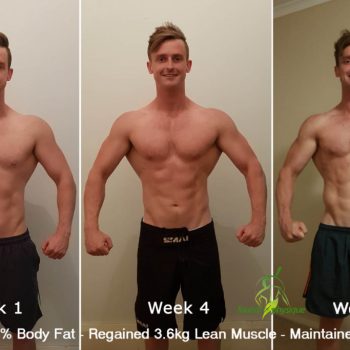
Make an amazing transformation, but remember, short term habits produce short term results. If you want to make a transformation that is “life changing”, be sure to learn plenty of nutrition and training along the way
If you are looking for scientifically proven methods of weight loss that are sustainable and also teach you about nutrition, how to build meals and how to achieve long term results, then you are in the right place.
After completing my nutrition degree at University of Wollongong, I started creating these methods based on science and the methods of experts from around the world. Whilst at F45, my clients were making epic transformations with less effort, I knew I had to share these methods with the world. Found My Physique was born.
If you are looking for long term results, a nutrition education and methods that are sustainable beyond the challenge, have a look at the personalised eating plans! The plans proven to make amazing transformations and don’t rely on you having to follow a strict cookie cutter routine or 5 meals per day with heaps of annoying ingredients. I let you choose the meals they want to be eating from a large list of healthy options and also how many meals per day, so the diets fit your lifestyle.

I hope you found this post valuable! Be sure to leave a comment if you think I have missed anything or share with a friend who is also doing the F45 challenge or diet plan.
Stay frosty,
Simon
Nutritionist
Owner of Found My Physique
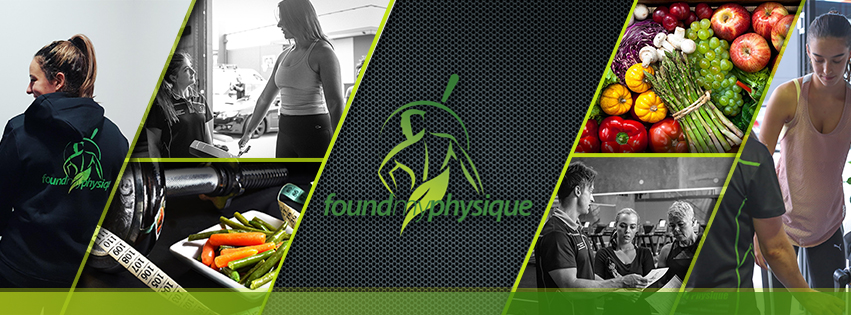
Fuel your potential with healthy nutrition. Found My Physique’s goal is to help make amazing body transformations easy, using proven nutrition and training protocols.

